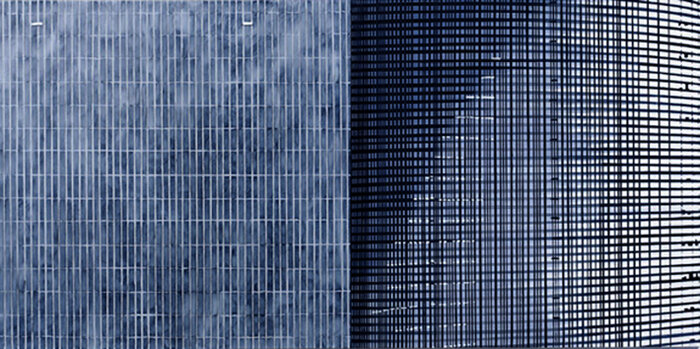THE AURORA BOREALIS IN A ZIP LOCK BAG : Essay about Leslie Parke's New Paintings by Christopher Millis
Little do I remember of the astronomy lecture I attended twenty some years ago on a warm summer night in an observatory on what may be the last densely wooded tract of land in Cambridge. What I do remember is that the lecture put me in a kind of swoon. For the first time in my life, science and poetry became one. Somehow a talk on chaos theory and its relation to the order of the universe – randomness as the predictable and necessary precursor to design – had the heft and elegance and perspicacity of a poem you want to memorize or a painting you don’t want to leave.
Leslie Parke’s paintings live at the same intersection where patterns court chaos, abstraction approaches the figurative and stasis hovers on the cusp of implosion. Her paintings are charged by contradictions: impersonal grids softened by sunlight; watery washes with metallic spikes; a cathedral of squiggles above a perfectly triangular black hole; the aurora borealis in a zip lock bag.
But even contradictions are connected by themes, and what’s most striking across these disparate, spirited works is their relentless energy. This is a painter who thrashes in her sleep. And it is not merely high-powered kinesis that comes through so much as the integration of movement, color and form.
It is no coincidence that the lines of “Silo” shift from vertical on the left half of the diptych to horizontal on the right; those same lines correspond with the play of light – muted to the left, increasingly luminous as the eye moves right. For all that it initially appears purely cerebral – the meticulous study of an industrial grid – the painting as a whole achieves the thrilling solace of a sunrise.
As with many artists at their performance peaks, Parke’s recent paintings seem deceptively effortless. They're not. Go back to them; they have a lot to say.
************
Christopher Millis Cambridge, MA. Christopher Millis’ criticism has appeared extensively in such publications as Art News, Artspeak, The Black American and The Boston Phoenix as well as on National Public Radio. He is the former editor of artsMEDIA Magazine in Boston.
Christopher Millis's writing has been published, produced and broadcast widely in the United States and Europe for the last twenty years. He has authored three books of poetry: The Handsome Shackles (2002,) Impossible Mirrors (1994,) and The Diary of the Delphic Oracle (1991,) and his poems have been featured in numerous magazines and anthologies. In 1994, his translations of the Triestine poet Umberto Saba appeared as The Dark of the Sun (University Press of America,) and the first of his acclaimed translations of Palestinian poet Mahmoud Darwish, "Requiem for Mohammed Al-Dura," was published in The London Review of Books in 2000. His translation of Darwish's "I Remember al-Sayyab" appeared in 2004 in The London Review of Books, The Daily Star, and The International Herald Tribune.
In 1979, Millis was commissioned by the Theater of the Open Eye in New York to write the libretto for Jean Erdman's dance opera The Shining House, a collaboration with Michael Czajkowski, Paul Jenkins and Ralph Lee. The Shining House established itself as part of the repertoire of Jean Erdman and Joseph Campbell's Theater of The Open Eye with productions until 1984. The following year, Poems for the End of the World (1985,) choreographed by June Anderson, appeared at the Merce Cunningham Dance Studio. Millis collaborated with Anderson and David Leisner on The Magnetic Properties of Moonlight at New York 's Dance Theater Workshop in 1986.
Millis's one-man autobiographical play Garbage Boy, directed by Ashley Lieberman, premiered to critical acclaim in Cambridge Mass. in 2004 and was included in the 2006 New York International Fringe Festival


